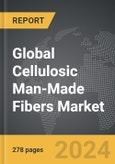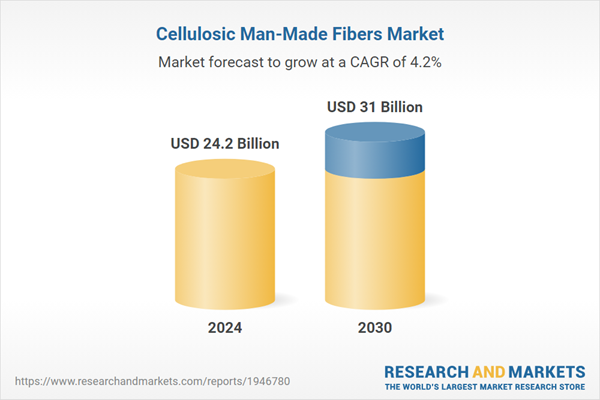Cellulosic Man-Made Fibers - Key Trends and Drivers
Cellulosic man-made fibers are derived from natural cellulose sources such as wood pulp, cotton linters, and bamboo, offering a sustainable alternative to synthetic fibers. The process of creating these fibers involves chemically processing the raw cellulose to form fibers that can be spun into yarns and fabrics. The most common types of cellulosic fibers include viscose, modal, and lyocell. Viscose, often referred to as rayon, is prized for its silk-like feel, excellent drape, and versatility, making it a popular choice for fashion garments, upholstery, and nonwoven products like wipes. Modal, which is processed under high tension, boasts superior softness, breathability, and absorbency, making it ideal for intimate apparel, activewear, and luxury bed linens. Lyocell, produced through a more environmentally friendly process known as the closed-loop process, is known for its strength, moisture-wicking properties, and biodegradability, making it suitable for a wide range of applications, from denim and dress fabrics to technical textiles and personal care products.Recent trends in the cellulosic man-made fibers market underscore a growing emphasis on sustainability and environmental stewardship. As concerns about the environmental impact of synthetic fibers intensify, both consumers and manufacturers are increasingly turning to cellulosic alternatives. Innovations in production techniques, such as the closed-loop process used in lyocell production, significantly reduce the environmental footprint by recovering and reusing solvents, thus minimizing waste and pollution. Additionally, the growing movement towards circular fashion, which promotes the recycling and reuse of materials, aligns perfectly with the biodegradable nature of cellulosic fibers. This has led to increased investment in research and development to enhance the performance characteristics of these fibers, such as improving their tensile strength, durability, and moisture management properties. Furthermore, the versatility of cellulosic fibers allows for their use in high-performance textiles and nonwoven fabrics, expanding their market potential beyond traditional applications.
The growth in the cellulosic man-made fibers market is driven by several factors. Firstly, there is an increasing consumer awareness and demand for sustainable and biodegradable textiles, which propels market expansion as more consumers seek eco-friendly alternatives to synthetic fibers. Secondly, technological advancements in fiber production, such as the development of eco-friendly lyocell and high-tenacity modal fibers, enhance product offerings and reduce the environmental impact of manufacturing processes. Thirdly, the expanding applications of these fibers in various end-use industries, including fashion, home textiles, and healthcare, create new growth opportunities. For instance, the use of lyocell in medical textiles due to its hypoallergenic properties and in high-performance sportswear for its moisture management capabilities highlights its versatility. Additionally, regulatory support for sustainable practices in textile manufacturing encourages the adoption of cellulosic fibers, with many governments implementing stricter environmental regulations and incentives for eco-friendly production methods. Lastly, shifting consumer preferences towards natural and comfortable fabrics, coupled with the rising popularity of athleisure and eco-fashion trends, further boosts demand. The combination of these drivers underscores the growing importance and potential of cellulosic man-made fibers in the global textile industry, positioning them as key players in the future of sustainable textiles.
Report Scope
The report analyzes the Cellulosic Man-Made Fibers market, presented in terms of units. The analysis covers the key segments and geographic regions outlined below.Segments: Application (Clothing, Fabrics, Spun Yarn, Other Applications).
Geographic Regions/Countries: World; United States; Canada; Japan; China; Europe (France; Germany; Italy; United Kingdom; and Rest of Europe); Asia-Pacific; Rest of World.
Key Insights:
- Market Growth: Understand the significant growth trajectory of the Clothing segment, which is expected to reach US$18.8 Billion by 2030 with a CAGR of a 4.2%. The Fabrics segment is also set to grow at 5.4% CAGR over the analysis period.
- Regional Analysis: Gain insights into the U.S. market, valued at $6.5 Billion in 2024, and China, forecasted to grow at an impressive 4.0% CAGR to reach $5.0 Billion by 2030. Discover growth trends in other key regions, including Japan, Canada, Germany, and the Asia-Pacific.
Why You Should Buy This Report:
- Detailed Market Analysis: Access a thorough analysis of the Global Cellulosic Man-Made Fibers Market, covering all major geographic regions and market segments.
- Competitive Insights: Get an overview of the competitive landscape, including the market presence of major players across different geographies.
- Future Trends and Drivers: Understand the key trends and drivers shaping the future of the Global Cellulosic Man-Made Fibers Market.
- Actionable Insights: Benefit from actionable insights that can help you identify new revenue opportunities and make strategic business decisions.
Key Questions Answered:
- How is the Global Cellulosic Man-Made Fibers Market expected to evolve by 2030?
- What are the main drivers and restraints affecting the market?
- Which market segments will grow the most over the forecast period?
- How will market shares for different regions and segments change by 2030?
- Who are the leading players in the market, and what are their prospects?
Report Features:
- Comprehensive Market Data: Independent analysis of annual sales and market forecasts in US$ Million from 2024 to 2030.
- In-Depth Regional Analysis: Detailed insights into key markets, including the U.S., China, Japan, Canada, Europe, Asia-Pacific, Latin America, Middle East, and Africa.
- Company Profiles: Coverage of players such as Aditya Birla Group, Baoding Swan Fiber Co. Ltd., Celanese Corporation, Century Rayon Limited, Daicel Corporation and more.
- Complimentary Updates: Receive free report updates for one year to keep you informed of the latest market developments.
Some of the 52 companies featured in this Cellulosic Man-Made Fibers market report include:
- Aditya Birla Group
- Baoding Swan Fiber Co. Ltd.
- Celanese Corporation
- Century Rayon Limited
- Daicel Corporation
- Eastman Chemical Company
- Formosa Chemicals & Fiber Corporation
- Glanzstoff Industries
- Grasim Industries Limited
- Indorama Ventures Public Company Limited
- International Paper
- Jiangsu Aoyang Technology Co. Ltd.
- Kelheim Fibres GmbH
- Lenzing AG
- Mitsubishi Chemical Corporation
- NRC Limited
- PT. South Pacific Viscose
- Smartfiber AG
- Tangshan Sanyou Xingda Chemical Fiber Co. Ltd.
- Thai Rayon Public Co. Ltd.
- Toray Industries Inc.
- Xinxiang Bailu Chemical Fiber Co. Ltd.
- Zhejiang Fulida Co. Ltd.
Tariff Impact Analysis: Key Insights for 2025
Global tariff negotiations across 180+ countries are reshaping supply chains, costs, and competitiveness. This report reflects the latest developments as of April 2025 and incorporates forward-looking insights into the market outlook.The analysts continuously track trade developments worldwide, drawing insights from leading global economists and over 200 industry and policy institutions, including think tanks, trade organizations, and national economic advisory bodies. This intelligence is integrated into forecasting models to provide timely, data-driven analysis of emerging risks and opportunities.
What’s Included in This Edition:
- Tariff-adjusted market forecasts by region and segment
- Analysis of cost and supply chain implications by sourcing and trade exposure
- Strategic insights into geographic shifts
Buyers receive a free July 2025 update with:
- Finalized tariff impacts and new trade agreement effects
- Updated projections reflecting global sourcing and cost shifts
- Expanded country-specific coverage across the industry
Table of Contents
Companies Mentioned (Partial List)
A selection of companies mentioned in this report includes, but is not limited to:
- Aditya Birla Group
- Baoding Swan Fiber Co. Ltd.
- Celanese Corporation
- Century Rayon Limited
- Daicel Corporation
- Eastman Chemical Company
- Formosa Chemicals & Fiber Corporation
- Glanzstoff Industries
- Grasim Industries Limited
- Indorama Ventures Public Company Limited
- International Paper
- Jiangsu Aoyang Technology Co. Ltd.
- Kelheim Fibres GmbH
- Lenzing AG
- Mitsubishi Chemical Corporation
- NRC Limited
- PT. South Pacific Viscose
- Smartfiber AG
- Tangshan Sanyou Xingda Chemical Fiber Co. Ltd.
- Thai Rayon Public Co. Ltd.
- Toray Industries Inc.
- Xinxiang Bailu Chemical Fiber Co. Ltd.
- Zhejiang Fulida Co. Ltd.
Table Information
| Report Attribute | Details |
|---|---|
| No. of Pages | 278 |
| Published | April 2025 |
| Forecast Period | 2024 - 2030 |
| Estimated Market Value ( USD | $ 24.2 Billion |
| Forecasted Market Value ( USD | $ 31 Billion |
| Compound Annual Growth Rate | 4.2% |
| Regions Covered | Global |









